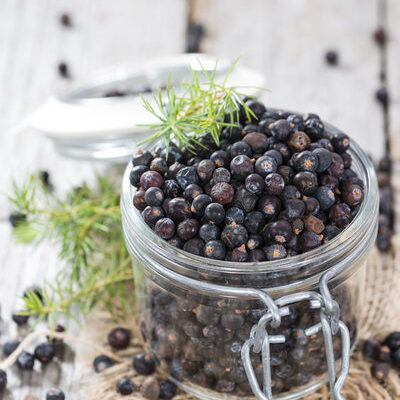
Juniper Berries
also known Mountain berry, Common juniper, Melmot berry, Ginepro
What are Juniper Berries?
Juniper berries (Juniperus communis) are the fleshy cones of female junipers with a physical appearance similar to that of berries. However, they are not actually “berries” but seeds. Juniper belongs to the family called Cupressaceae (also known as the pine family).
- Some species of this berry are red when ripe, while others are blue.
- Juniper has a strong, peppery, and pine-like flavor, which lends itself well to a variety of drinks and dishes.
Ten common species of juniper trees and shrubs are:
- Alligator
- California
- Chinese
- Common
- Creeping
- Drooping
- Eastern Red Cedar
- Greek
- One-seed Juniper
- Rocky Mountain
Origin of juniper berries
This berry has served various culinary and medicinal functions over the centuries. In 1500 BC, one of the earliest therapeutic functions of these berries was to cure tapeworm. The Romans used it as a remedy to aid digestion. The Greeks used these berries as medicine before discovering their culinary uses. The Greeks also believed that these berries provided athletes with solid physical stamina.
Central European folk medicine also considered them a cure for cholera, dysentery, and typhoid disorders. By the 17th century, juniper berries were used to flavor food in the Netherlands. Later on, the Scottish began to use juniper berries as a flavor in their whiskey. Today, these berries are still valued for their many culinary uses.
Function
The different parts of the juniper plant serve various purposes. The oil from juniper berries serves as a flavor for gin or tea. In the kitchen, people crush this berry and apply it to meat before roasting it. It is also used in vegetable dishes and spices. Furthermore, the dense evergreen foliage of this plant makes it suitable for ornamental purposes.
Nutrition
In a serving size of 0.25 teaspoon (7g) of juniper berries, there are:

This berry has some health benefits, which include:
- Juniper berries have essential oils and flavonoids that provide anti-inflammatory functions.
- They might be capable of fighting against diabetes as they increase heart-protective HDL (good) cholesterol.
- These berries might be able to promote a healthy heart by reducing LDL (bad) cholesterol.
- This food might be capable of fighting bacterial and fungal infections.
- Juniper berries are rich in vitamin C, which is vital for immune health and blood vessel function.
However, these berries have some significant side effects. For instance, juniper berry supplements are not ideal for children or pregnant women. These supplements can cause miscarriage in high doses because they are uterine stimulants. They can also interact with psychiatric and diuretic drugs.
Commercial production
Juniper plants grow well under sunny conditions and adequately drained soil. These plants don’t need too much watering. Slightly acidic soil is the best for this herb. Also, it does not need much pruning or application of insecticides and fertilizers. Once the berries have grown, they are harvested, dried, and packaged or sent off for further processing.
Application
When you use juniper berries in foods, their flavor can dominate a dish. Therefore, it’s recommendable to use one crushed berry for four portions of the dish you are preparing.
The best way to store these berries is to dry them. They will dry indoors at room temperature within three weeks. Unripe berries cannot dry properly, so it’s best to discard them. Once you have dried these berries, place them in an airtight container away from direct sunlight.
Juniper berries recipes
This berry works well in both sweet and savory dishes. Some high-rated recipes to try include:
- Juniper Berry Spiced Chocolate Hazelnut Cookies
- Garlic Potatoes with Juniper Berries
- Juniper Tincture & Simple Syrup
- Slow-cooked Pork Ribs with Braised Monkfish and Pickled Cabbage
- Port, Juniper, and Orange Pork Chops
FDA regulation
The Food and Drug Administration classifies juniper berries (Juniperus communis L) as a safe substance for its intended use. The organization categorized it among essential oils, oleoresins (solvent-free), and natural extractives (including distillates). Nonetheless, one variety of this berry, known as Juniperus sabina, is listed on the FDA’s Poisonous Plant Database, making it unsafe to use.
References
Miller, Renee. “What Do Juniper Bushes Look Like?” SF Gate, SF Gate, 17 Nov. 2020, homeguides.sfgate.com/juniper-bushes-look-like-92683.html.
Kubala, Jillian. ”5 Emerging Benefits of Juniper Berries.” www.healthline.com, Healthline Media, 30 Aug. 2019, https://www.healthline.com/nutrition/juniper-berries
“CFR – Code of Federal Regulations, Title 21.” accessdata.fda.gov, US Food & Drug Administration, 1 Apr. 2019, www.accessdata.fda.gov/scripts/cdrh/cfdocs/cfcfr/CFRSearch.cfm?fr=582.20.
